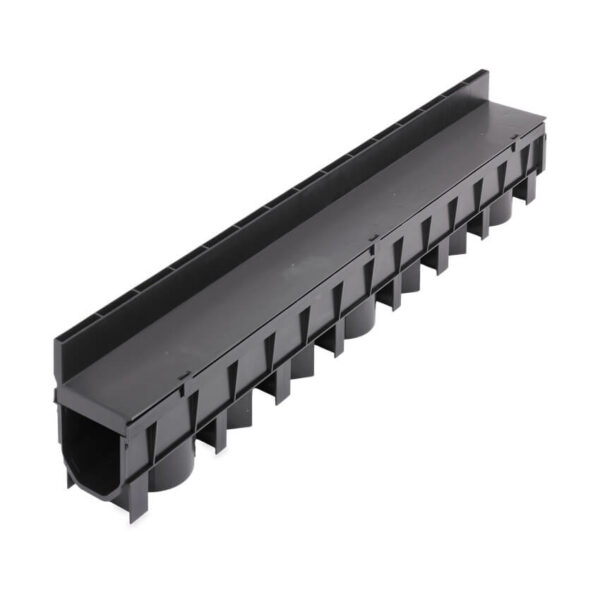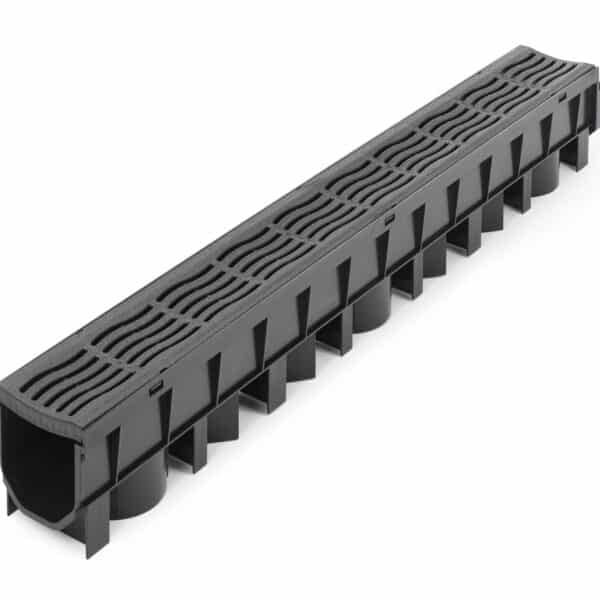A channel drain, also known as trench drains or drainage channels, are linear drainage systems that are used to collect and remove excess water from a variety of surfaces. Channel drains are most commonly used on driveways, patios, pavements, and other areas where water can pool and cause problems. Channel drains are typically made from concrete, plastic, polymer or metal and are available in a variety of sizes and styles. In this blog post, we’ll discuss everything you need to know about channel drains, including how they work, the benefits of using them, and how to install them.
View our range of Drainage Channels here.
How A Drainage Channel Works
Channel drains work by collecting excess water and directing it away from the surface where it can cause problems. The drains consist of a number of different parts, including a grate, a catch basin, a pipe, and an outlet. The grate is located at the surface and is used to collect water. The catch basin is located underneath the surface and collects water from the grate. The pipe then carries the water away from the catch basin to the outlet. The grate on top allows water to enter the drain while preventing debris from clogging it.
The Benefits of Using Channel Drains
There are many benefits to using channel drains. One of the biggest benefits is that they can help prevent flooding by collecting and conveying water away from the surface. Another benefit is that they can help reduce erosion by redirecting surface water away from vulnerable areas. Additionally, channel drains can help improve drainage in your garden, patio or on your property overall. They can also increase your home’s curb appeal by preventing pooled water from accumulating on your driveway, patio or pavement. They can increase the aesthetic appeal of your property by hiding unsightly drainage pipes and catch basins. When installed properly, they can blend in with their surroundings and become virtually invisible. This can be a major selling point if you are trying to sell your home or business
A drainage channel can also be relatively easy to install and can require little maintenance once they are in place. In addition, channel drains can be used in conjunction with other types of drainage systems, such as French drains, to create an even more effective solution for managing excess water.
How to Install Channel Drains
Installing channel drainage is typically a job for a professional contractor. But at times some homeowners may opt to install channel drains themselves as it can be relatively simple and can usually be done by anyone with basic do-it-yourself skills.
The first step is to determine where the drain will be installed and how it will connect to the existing drainage system. Once that has been determined, the contractor will excavate a trench for the drain and install the drain pipe. They will then install the grates over the top of the drain and backfill the trench.
If you want to know how to install a channel drain yourself, first, you’ll need to dig a trench that is big enough to accommodate the drain components, slightly wider and deeper than the drain you will be installing. Then line the trench with gravel or stone before placing the drain in position. Next, you’ll need to assemble the drain components in the trench according to the manufacturer’s instructions. Finally, you’ll need to fill in the trench around the drain components with soil or gravel, and compact it down to secure the drain in place.
Do you need a slope for a drainage channel?
In order for drainage channels to work properly, they need to have a slight slope. This allows water to flow into the drain and through the pipe to the outlet. The sewer pipe that the drainage channel is connected to also needs to have a slope in order for the water to flow properly. Most experts recommend a minimum slope of 1/8 inch per foot for both the drainage channel and the sewer pipe.
Where should a drainage channel be placed?
Drainage channels should be placed around the perimeter of a property in order to collect water from runoff. They can also be placed in other areas where there is a problem with pooled water, such as next to a driveway, sidewalk or patio.
What are the different types of channel drains?
There are two main types of channel drains: surface drains and subsurface drains. Surface drains are installed at the surface of the ground and typically have a grate on top to collect water. Subsurface drains are installed underneath the surface of the ground and do not have a grate. Instead, they rely on gravity to collect water and direct it into the drain pipe.
There are two main types of materials for drainage pipes: corrugated pipes and PVC pipes. Corrugated pipes are made of ribbed metal or plastic and are typically used for surface drains. PVC pipes are made of smooth plastic and are typically used for subsurface drains.
How much does it cost to install a drainage channel?
The cost of installing a drainage channel will vary depending on a number of factors, such as the size and type of drain, the location of the drain and whether or not you hire a professional contractor.
How deep should the drainage channel be?
The depth of the drainage channel will vary depending on the type of channel drain you are using. Surface drains should be installed at least 6 inches deep, while subsurface drains can be installed as deep as 10 feet.
How long do drainage channels last?
Drainage channels are durable and can last for many years. However, they may eventually need to be replaced due to wear and tear or damage from flooding or other events.
What are the disadvantages of using a channel drain?
There are a few potential disadvantages to using a channel drain, including:
– They can be expensive to install, especially if you hire a professional contractor
– They require regular maintenance to keep them functioning properly
– If they are not installed properly, they can actually worsen drainage problems
How do you fit drainage channel to drain?
The drainage channel should be fitted to the drain using a coupling. The coupling will connect the channel to the drain pipe and allow water to flow from the channel into the pipe.
How do you clean a blocked drainage channel?
If your drainage channel becomes blocked, you can clean it by removing any debris that is blocking the flow of water. You may also need to flush out the channel with a hose to remove any build-up of sediment.
What is the difference between a channel drain and a French drain?
A channel drain is a type of surface drain that is installed at the ground level. A French drain is a type of subsurface drain that is installed underneath the ground.
What is the difference between a channel drain and a sewer pipe?
A channel drain is a type of surface drain that is used to collect water from runoff. A sewer pipe is a type of subsurface drain that is used to carry wastewater away from a property.
Can you connect downpipe to channel drain?
Yes, you can connect a downpipe to a channel drain. The connection can be made using a coupling.
What is the best type of drainage pipe?
The best type of drainage pipe for your needs will depend on a number of factors, such as the location of the drain and the amount of water that needs to be drained.
How do you keep dirt out of a channel drain?
You can keep dirt and debris out of your channel drain by regularly cleaning it and by installing a grate or cover over the drain.
What is the best way to clean a drainage channel?
The best way to clean a drainage channel is to use a power washer. You can also use a garden hose with a spray attachment. Simply direct the water into the drain and let it run through the system. This will flush out any debris that may be blocking the drain. If you have a lot of debris in your drain, you may need to repeat this process several times. You can also use a drain snake to remove any clogs in the drain.
How do I remove channel drain cover?
You can remove the channel drain cover by unscrewing it or lifting it off of the drain. You may need a screwdriver or other tool to remove the cover.
My channel drain is leaking, what do I do?
If your channel drain is leaking, you may need to replace the coupling that connects the drain to the pipe. You may also need to seal any cracks or gaps in the drain.
Conclusion
Drainage Channels are an effective drainage solution in providing a way to collect and remove excess water from a variety of surfaces. They offer many benefits, including preventing flooding, reducing erosion, improving drainage, and increasing curb appeal and are easy to maintain. Installing linear drainage is relatively simple and can usually be done by a homeowner without any problem. However, if you are considering adding a drainage channel to your home or business, be sure to consult with a professional drainage contractor to ensure proper installation and function. If you’re looking for an effective way to manage runoff water on your property, then drainage channels may be right for you!


















